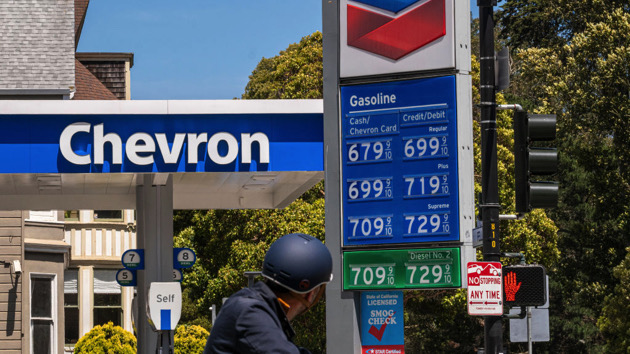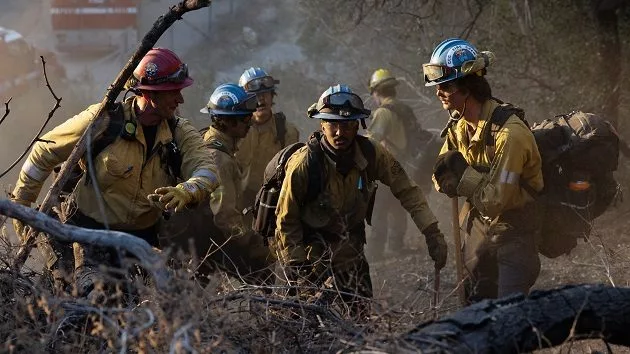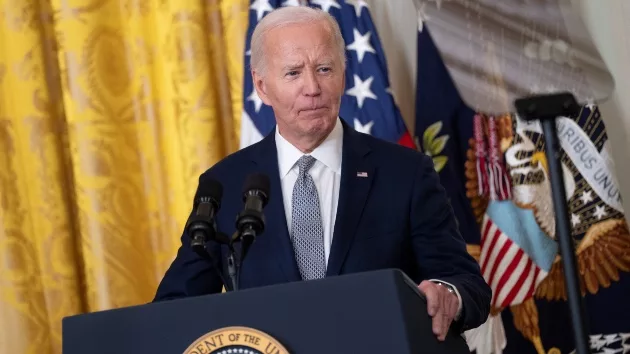
(NEW YORK) — The pain at the pump is getting worse and has motorists asking, is there any relief in sight?
The average nationwide price of a gallon of gas surpassed an all-time high of $5 last week, according to GasBuddy. In California, the state with the highest average gas price, drivers are paying an eye-popping $6.43 per gallon, AAA data showed.
The price surge owes to the fundamental economic principle of supply and demand, experts told ABC News. Summer travel has sent Americans to the pump at a time when the global market is experiencing a shortage of crude oil supply after the Russian invasion of Ukraine, which pushed millions of barrels of oil off the market.
And the current crisis exacerbates a supply crunch that has endured from a pandemic-induced production slowdown that hasn’t caught up with the renewed surge in demand, the experts said.
The sky-high prices with no relief in sight have set off sharp disagreement among public officials over what should be done in response. Republican members of Congress have faulted President Joe Biden for the price increases, citing what they’ve described as his “war on American energy.” At the same time, Biden has blamed the price surge on the Russian invasion of Ukraine, repeatedly calling it “Putin’s price hike.”
Government policy cannot meaningfully relieve the price increases in the short term, besides an additional release of oil from the strategic reserve or a gas tax holiday, each of which would likely reduce just a fraction of the cost, experts told ABC News. But steps taken now could help foster decreases over the long term and insulate the market from future disruptions, they added.
“There are not the overnight kind of solutions,” said Stewart Glickman, an energy analyst for CFRA Research. “In the longer term, they might make a difference.”
Here are some potential policy solutions to the gas price crisis and whether the experts think they would work.
Releasing more oil from the Strategic Petroleum Reserve
In March, the U.S. announced a commitment to release about 1 million barrels per day from its Strategic Petroleum Reserve, or SPR, over the ensuing six months — a move that aimed to alleviate some of the supply shortage and blunt price increases. The decision came alongside similar announcements from some U.S. allies.
The release of oil from the U.S. SPR is offering slight relief for the rise in the price of gasoline, some experts told ABC News. “The price of oil would be even higher without those stockpiles being used,” said Pavel Molchanov, a senior energy analyst at Raymond James.
If the U.S. decided to release even more oil from its reserves, the move could marginally slow the rise in gas prices even further, the experts said. But the Biden administration should think twice about expanding its release of reserve oil because it could drain the 700 million-barrel stockpile, enough to release 1 million barrels per day for nearly two years, Molchanov said.
“We need to be responsible about it,” Molchanov said. “We cannot use all of those stockpiles in one fell swoop.”
Encouraging domestic oil production
On Wednesday, Biden sent a letter to major oil refinery companies calling on them to take “immediate actions” to increase output. The letter accused the companies of taking advantage of the market environment to reap profits while Americans struggle to afford gas, and it mentioned the possibility of Biden invoking the Defense Production Act, which requires companies to produce goods deemed necessary for national security.
Glickman, the energy analyst at CFRA, said the move from Biden is unlikely to increase supply and lower gas prices, since the domestic industry is already operating at as high as 96% capacity. The refineries cannot add capacity in a short period of time, Glickman added.
Biden is “missing the point a little,” Glickman said. “These are industrial systems that move like battleships, not dinghies.”
U.S. oil refinery capacity stands 1 million barrels per day lower than pre-pandemic levels because several refineries have been closed or converted since early 2020, according to the U.S. Energy Information Administration, or EIA. Refinery inputs for the second and third quarter of this year will average 16.7 million barrels per day, the agency said.
One approach to incentivizing an increase in U.S. production includes a potential tax on oil company profits. But such a move wouldn’t remove the impediments to greater oil production capacity, Glickman said.
“Whether you do something like taxing the industry or not, it isn’t going to change how much capacity you bring back,” he said.
Some Republican members of Congress have criticized Biden for drilling permit restrictions and the shuttering of the Keystone XL Pipeline last year. But oil production in the U.S. last year was nearly identical to that seen over the final year of the Trump administration, in 2020, and greater than the amount produced in 2017 or 2018, according to data from the EIA.
U.S. oil production increased throughout the years of the Trump administration until a sharp, pandemic-induced drop that began in 2020, according to EIA data.
Loosening restrictions on oil drilling would yield long-term gains in oil supply, said James Coleman, an energy policy expert at the conservative-leaning think tank American Enterprise Institute.
“If you were to reform those, it would take a while to have an impact on oil and gas markets,” Coleman said. “On the other hand, if you’re in a hole, maybe the first step is to stop digging.”
Overall, increased U.S. oil production would help reduce gas prices over the next five or 10 years, and protect the industry from future supply shocks, the experts said. However, some experts noted that the sector’s reluctance to aggressively expand production owes to fiscal discipline imposed by shareholders as well as the continued rise of renewable energy. “We know the energy transition is coming at some point,” said Glickman, the CFRA analyst.
Gas tax holiday
A handful of states — led by both Democratic and Republican governors — have suspended their gas taxes as a means of delivering some financial relief for drivers. But the moves only reduce costs by a fraction of the price. In New York State, for instance, Gov. Kathy Hochul this month suspended a roughly 16-cent-per gallon tax. With the average price of a gallon of gas in New York standing at $5, according to AAA, the tax relief amounts to a 3.2% cost reduction.
The federal government could move forward and suspend its gas tax, which amounts to 18.4 cents per gallon. But such a move would also reduce the cost of a $5 gallon of gas by less than 5%. Still, consumers would likely prefer some relief to no relief.
But suspending the gas tax would take away a key policy tool for discouraging the use of gasoline for other purposes, and it would remove a funding source targeted specifically for infrastructure, Adam Hersh, senior economist at the liberal-leaning Economic Policy Institute, told ABC News.
“The gas tax plays a role in disincentivizing the use of gasoline for other energy sources and transportation methods, as well as being tied to funding sources for infrastructure investment,” he said.
Copyright © 2022, ABC Audio. All rights reserved.





